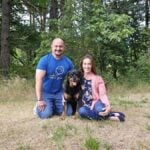


Home » Janis Rosenthal | Chevaliers du Roland

Janis Rosenthal
1. I live in Brooksville, Florida. I have been in dogs for almost 50 years, spending the last 15 years as a breeder. I currently operate under the kennel name Chevaliers du Roland; however, I bred Beauceron litters under Cotes du Noires.
2. My litters of Anatolian Shepherd Dogs are divided into show and guardian in lieu of show and performance. Some of my puppies do both. My process includes careful observation of puppies from birth. Guardian puppies are more reserved and alert to things that shouldn’t be there, even at an early age. Conformation is important, but not as important as being able to do their job. All prospects are evaluated at six weeks and eight weeks for conformation in addition to the constant observation for guardian instinct. Those with the best combination of people orientation and conformation are likely show prospects. I breed puppies that are successful in the show ring and in the pasture, guarding. I truly believe the breed should do both.
3. The show kennels are doing a good job teaching the working kennels about AKC registration and health testing. However, in states like Texas and California, the kill shelters are full of strays and surrendered dogs. Kudos to those bringing attention to the crisis and those fostering in conjunction with rescues. It breaks my heart to see this.
4. The sport today differs from the sport I grew up in. Social media has made it both easier and harder to guide people through the Breed Standard. Like so many breeds, people want to breed to, and reward, those dogs that are winning, not necessarily the correct dogs showing. I see more judges applying the Standard to those in the ring more than they used to. That is heartwarming to see. Having lived in an “open” state during COVID, I saw the number of shows drop dramatically and everyone came to Florida to show. I am happy to see the shows available throughout the country offering so much to both seasoned veterans and newcomers.
5. Well, social media is a double-edged sword. It allows people to reach out, join groups, and learn about every breed in the world (literally). However, it also allows for more bullying and nastiness because people don’t actually see each other and communicate face to face. I am glad that AKC also sees both sides and will moderate social media sportsmanship issues.
6. The biggest challenge facing many breeds, including mine, is breeding for generational winners, not just the single dog of a lifetime. For example, to win Best of Breed at a National or Westminster three times in a row with a single dog is exceptional. But to win three times with three different generations is a tribute to an exceptional breeding program. Preservation breeders don’t just breed to win, they breed to better the breed so that it has form and function, generation after generation. That is key.
7. One of the positive changes is Juniors aligning with a specific handler who mentors them day after day, year after year. Juniors are the future. Also, attracting new people to all aspects of the sport is beautiful to see. If I can help answer some questions, I am always happy to do so.
The show kennels are doing a good job teaching the working kennels about AKC registration and health testing.